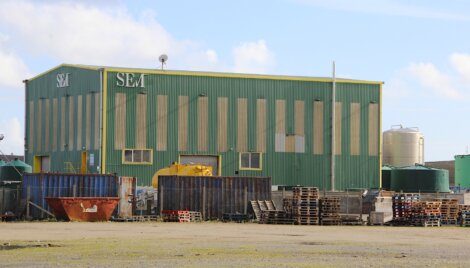Business / Plans to produce fertiliser and biodiesel as by-products of dead fish
THERE are plans for a facility in Lerwick which would turn dead fish into fertiliser as well as biodiesel.
SEM Energy has successfully applied to vary its licence with the Scottish Environment Protection Agency (SEPA) for the project.
The licence for the company’s existing facility at the Greenhead Base is for storing and processing dead fish, but the variation will allow staff to extract valuable resources from the waste.
It is proposed that around 3,500 tonnes of category two fish mortality waste would be received every year.
Creating sustainable by-products, the solids would be used for fertiliser production, and the resulting fish oil would go towards the production of biodiesel.
A spokesperson for SEM said: “We are engaged with a variety of stakeholders across the islands with the objective of achieving best available practice, and during this process to date, we aren’t aware of this type of process happening elsewhere in Shetland.”
Biodiesel is a form of fuel derived from plants or animals, and it offers carbon savings compared to traditional diesel.
There is said to be a growing demand for biodiesel, and SEM has received interest from industries such as agriculture, marine, power generation and transport.
And the company might not stop at fertiliser and biodiesel, with research ongoing into “additional applications and markets”.
SEM recently sought to recruit a manager for its Lerwick site, overseeing the daily operations of the fish acceptance and processing facility.
Head of project delivery Gary Broadley said the project fits in with the company’s wider portfolio of services, “which are focused on reducing CO2 emissions, repurposing waste and protecting our precious waters”.
“We are working with our partners in the aquaculture industry in Shetland, and beyond, as they seek to operate in a consistently ethical and environmentally responsible way,” he added.
Become a member of Shetland News
“We support them to manage their waste streams in line with the twin aims of compliance and CO2 reduction, but also with the potential to generate high-value by-products as part of the circular economy.”
Broadley said the company continues to work closely with SEPA, as well as the government’s Animal and Plant Health Agency (APHA), to ensure that the Gremista facility is “best in class”.
There is also a planning application to extend SEM’s existing premises.
Broadley said this “forms part of our plan to exceed, wherever possible, the requirements of the regulatory bodies”.
“Having worked with local businesses and community groups to develop the site since the outset, we are very proud to be part of the Shetland business community, and look forward to developing these relationships further as the project progresses,” he added.
Become a member of Shetland News
Shetland News is asking its many readers to consider paying for membership to get additional features and services: -
- Remove non-local ads;
- Bookmark posts to read later;
- Exclusive curated weekly newsletter;
- Hide membership messages;
- Comments open for discussion.
If you appreciate what we do and feel strongly about impartial local journalism, then please become a member of Shetland News by either making a single payment, or setting up a monthly, quarterly or yearly subscription.


























































